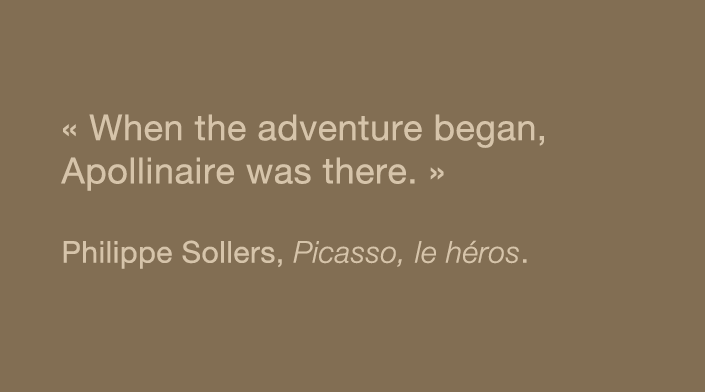Apollinaire, Picasso's first theoretician
Apollinaire began his friendship with Picasso in 1905. He admired the painter's compositions and went to see him often at the Bateau-Lavoir, where he was a regular visitor. Early on, Picasso barely invited anyone other than his Spanish friends, but his circle widened with Max Jacob and André Salmon, and the jovial presence of Guillaume Apollinaire was a welcome addition. The poet published in magazines that were not yet well known, but his name was already out there and his undeniable talent for turning the slightest platitude into poetic beauty opened many doors for him. Guillaume Apollinaire introduced Picasso to the Parisian intellectual life of their generation.
Perfectly attuned to the historical moment and to the aesthetic revolution that gave rise to modern art, Apollinaire was at the forefront of all avant-garde movements. His first essay on Picasso was published in La Revue immoraliste in 1905 and then reprinted in the May 15 issue of La Plume that same year. "It was a review of Picasso's exhibition at Galerie Serrurier, where he revealed what would later be referred to as his 'rose period', that is, his Harlequin period. In the text, Picasso found a transcription that was all the more valuable to him since at the time he was selling nothing."[1] "Some claim that these pieces by Picasso reflect an early disenchantment. I disagree: he's enchanted by everything, and his undeniable talent strikes me as being at the service of a fantasy that aptly combines the delicious with the horrible, the abject with the delicate."[2] In a sense, Guillaume Apollinaire became Picasso's first theorist. Always at the heart of the aesthetic debates that gave rise to modern poetry, he was to play a key role in the theorization of Cubism.
[1] Pierre Daix, Dictionnaire Picasso, "Apollinaire", éditions Robert Laffont, 1995, pp. 24-25.
[2] Guillaume Apollinaire, "Picasso, peintre et dessinateur (galeries Serrurier)", in Œuvres en prose complètes, texts compiled, edited and annotated by Pierre Caizergues and Michel Décaudin. Gallimard, Bibliothèque de la Pléiade, 1993, vol. II, p. 78.






 Summary
Summary